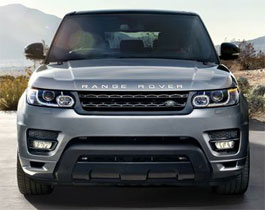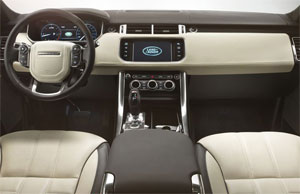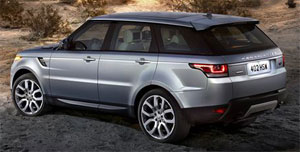2014 Land Rover Range Rover Sport
With last year’s near total transformation of Land Rover’s Range Rover, sales for the ruggedly premium utility brand are up double digits. Indeed, November was one of their best U.S. sales months ever. Well, now they hope to spread a little of that success to their bestselling model, the Range Rover Sport. So, let’s find out if they can keep the momentum going.
A big part of the 2014 Range Rover Sport’s appeal is, without a doubt, that “go anywhere in luxury” tradition of the Land Rover brand. But just like many other builders of traditional SUVs, if they want to increase sales numbers, as Land Rover surely does, their utilities will have to become even more refined.
 And, that’s clearly what was intended with the new Sport. Developed alongside the also-new Range Rover that launched just last year, the Sport shares the same all-aluminum architecture and 800-pound weight loss despite growing larger and more functional.
And, that’s clearly what was intended with the new Sport. Developed alongside the also-new Range Rover that launched just last year, the Sport shares the same all-aluminum architecture and 800-pound weight loss despite growing larger and more functional.
For differentiation, the Sport’s front-end styling is more Evoque than Range Rover, but with the slant-back image of previous generations still intact. It looks slick and rugged; though more than a few of our staffers also pointed out a resemblance to the Ford Explorer. The blacked out pillars and rear glass give it a wraparound visor treatment, with a thick spoiler topping the hatch.
V6 models ride on 19-inch wheels, V8s on 20s. Both V6 and V8 come supercharged, with an incredibly smooth 8-speed automatic transmission and permanent 4-wheel-drive.
The brute of the two V’s is our tester’s 5.0-liter eight. It cranks out 510-horsepower and 461 lb-ft. of torque, and sounds nastier than any SUV we can remember.
 But it’s the interior presents perhaps the biggest visual change where things are simpler, cleaner, more logical, all while becoming roomier. Space was sorely needed in the back seat where the added leg room is appreciated. Still even more is needed for normal adults so those in the front don’t have to move their seats forward.
But it’s the interior presents perhaps the biggest visual change where things are simpler, cleaner, more logical, all while becoming roomier. Space was sorely needed in the back seat where the added leg room is appreciated. Still even more is needed for normal adults so those in the front don’t have to move their seats forward.
New this year is an optional child-size third row. There are loads of interior choices for color and wood tones, and just about all the creature comforts you could ask for including a big sunroof and power rear hatch. Everything works well, and the IP layout is excellent; a beautiful mix of needles and dials with the digital age meeting Land Rover tradition.
Despite the increasingly refined nature, on the road it still feels like a truck, which is just fine by us. It soaks up road imperfections much better than before, there’s a commanding view from the driver’s seat, and no matter the road surface it feels incredibly composed, smooth, and never harsh. It’s probably the best riding SUV out there, managing to still feel like a Land Rover with that go anywhere sensation, just a super smooth one.
Even at higher speeds, the Sport feels flat and sporty, making you want to go faster than you should through corners, but don’t worry, electronic nannies have your back. For a vehicle that weighs over 47–hundred pounds it responds very light. The Enhanced Electronic Air suspension’s Auto mode reacts promptly, and Dynamic mode firms things up to sport sedan territory. Land Rover claims it’s their most agile UTE ever, and we can’t help but agree.
An early winter storm prevented us from really pushing the Sport to its limits at our test track, but did provide us a chance to fully experience Terrain Response 2’s snow setting. While the standard V6 is probably more than up to the task of carpooling and mall running, it’s big V8 power that we crave and the Sport has a huge amount of it, delivering it in a very luxury car-like fashion.
 Acceleration is brisk, hitting 60 in as little as 5.0-seconds. Of course you have to pay on the back end with Government Fuel Economy Ratings of 14-City, 19-Highway, and 16-Combined. We managed 16.6 miles-per-gallon of Premium in mixed driving. That makes for a poor Energy Impact Score, with 20.6-barrels of oil being consumed per year and 9.4-tons of CO2 emitted.
Acceleration is brisk, hitting 60 in as little as 5.0-seconds. Of course you have to pay on the back end with Government Fuel Economy Ratings of 14-City, 19-Highway, and 16-Combined. We managed 16.6 miles-per-gallon of Premium in mixed driving. That makes for a poor Energy Impact Score, with 20.6-barrels of oil being consumed per year and 9.4-tons of CO2 emitted.
If we’ve got a nit to pick, it’s the very noticeable stop/start system, though some harshness might be expected when you’re instantly igniting this much engine. But, you really don’t expect any roughness with a vehicle with a base price of $63,495. V8’s begin at $79,995.
So you’ll need to bring the bucks, but you will be very satisfied; as there’s no denying that the 2014 Land Rover Range Rover Sport is vastly better than before. It’s a lot more refined without losing any of its Land Rover-ness. A formula that many other brands have been unable to duplicate, and a recipe that will keep the momentum going for Land Rover.
Specifications
- Engine: 5.0-liter
- Horsepower: 510
- Torque: 461 lb-ft.
- 0-60 mph: 5.0 seconds
- EPA: 14 mpg city/ 19 mpg highway
- Energy Impact: 20.6 barrels of oil/yr
- CO2 Emissions: 9.4 tons/yr
2025 Kia K4
Kia Crams Premium Midsize Sport Sedan Into Compact K4
Kia has a new paint by numbers product strategy; first, trading in years of Optima equity to rename their midsize sedan the K5, and second, giving their compact Forte a reboot as the K4. So, let’s see if it all makes for a brighter spectrum for Kia.
Sometimes a vehicle gets such a drastic update that the brand feels an entirely new name is appropriate. That’s the case here, as we’re saying good-bye to the Kia Forte and hello to this 2025 Kia K4 sedan. We’ve been down this road before, as the Forte itself was once a replacement, taking over for the Spectra in 2010.
Whatever they’re calling it these days, it is easily one of the smoothest compact cars we’ve ever driven, from Kia or anyone else. It packs in lots of tech, too, with 11 active driving assist features standard and up to 29 available including Emergency Evasive Steering Assist. A 30-inch-wide housing contains both the 12.3-inch digital gauge display and a 12.3-inch touchscreen for infotainment; but, unlike other similar setups, it’s integrated into the dash more than just sitting on top of it. While there are lots of standard features as we’ve come to expect from Kia, they’ve pumped up high-end add-ons too, including Harmon Kardon premium audio, multi-colored ambient lighting, and sporty SynTex covered seats that are both heated and ventilated.
Rear-seat headroom and legroom are both excellent for the class, approaching midsize territory. All the additional space comes from a wheelbase increase of about an inch over the Forte sedan; it’s also almost 2-inches wider.
The K4 is a great looking compact four-door too, but with sport sedan proportions and a definite hatchback vibe. And on that subject, a five-door will join the sedan late this year, something that’s been missing in Kia’s compact ranks since the Forte5’s run ended in 2018. In the meantime, you’ll just have to make do with this still huge 14.6 cu-ft trunk for storage, extended by split folding rear seat backs.
Easily one of the most fun compacts we’ve driven this year.
Standard power comes from a 147-horsepower naturally-aspirated 2.0-liter I4 which carries over unchanged from the Forte. But if you can swing it, we highly recommend stepping up to this 1.6-liter turbo-four found in the GT-Line Turbo. Its 190 horsepower and 195 lb-ft of torque moves things from commuter car closer to sport sedan territory. It also gets you a true eight-speed automatic transmission in place of the standard CVT, and 18-inch wheels.
At Mason-Dixon Dragway, it didn’t exactly pounce off the line, but there was a nice punch of power when the turbo was fully spooled up, getting us to 60 in 6.7 seconds. Not as quick as some competitors, but that’s much improved compared to the 8.1-second runs from the Forte with the 2.0-liter. We found the eight-speed to prioritize smoothness over sportiness, however, resulting in quarter-mile times of 15.3 seconds at 95 mph. There wasn’t a whole lot of engine noise, but we really felt that small powerplant working overtime moving down the track.
The GT-Line puts some credence to the term “sport-tuned suspension” by ditching the standard car’s rear torsion beam for a multi-link setup, working with grippier 18-inch tires, and a quicker steering ratio. It had us whipping in and out of the cones with ease, feeling quick and agile; easily one of the most fun compacts we’ve driven this year. There was very neutral behavior, as we scooted through our handling course at Porsche-like speeds. Steering was light but still gave us plenty of feedback; and no matter how hard we pushed, stability systems stayed out of the way. The GT-Line Turbo gets 1-inch-larger front brake rotors too; they delivered plenty of feedback and consistent fade-free short stops, averaging just 100 feet from 60 with minimal nosedive.
Government Fuel Economy Ratings with the turbo are 26 city, 36 highway, and 29 combined. Our highway-heavy mileage loop returned 35.0 mpg of regular. That’s a better than average Energy Impact Score, using 10.3 barrels of oil annually with 5.0 tons of CO2 emissions. K4 pricing starts with LX at $23,165 and tops out at the GT-Line Turbo for $29,265.
At its essence, the automotive industry is just a big numbers game. Whether we’re talking about dollars, horsepower, fuel economy, tow ratings, 0-60s, storage capacity, it’s all just numbers. But more often than not, it’s the things that fall between the numbers that really make the difference, and Kia has been winning that game for years. Considering this 2025 Kia K4 sedan offers features and a level of sophistication well above its price point, it looks like that winning streak will continue.
Specifications
As Tested
- Engine: 1.6-liter turbo-4
- Transmission: 8-speed automatic
- Horsepower: 190
- Torque: 195 lb-ft
- EPA: 26 City | 36 Highway | 29 Combined
- 0-60 mph: 6.7 seconds
- 1/4 Mile: 15.3 seconds at 95 mph
- Braking, 60-0 (avg): 100 feet
- MW Fuel Economy: 35.0 mpg (Regular)
























































